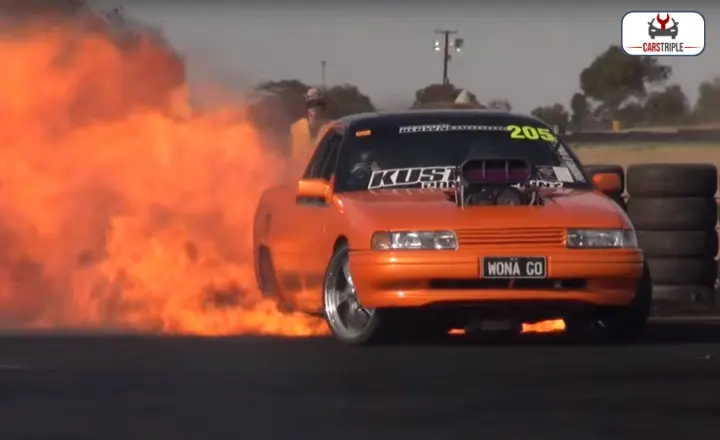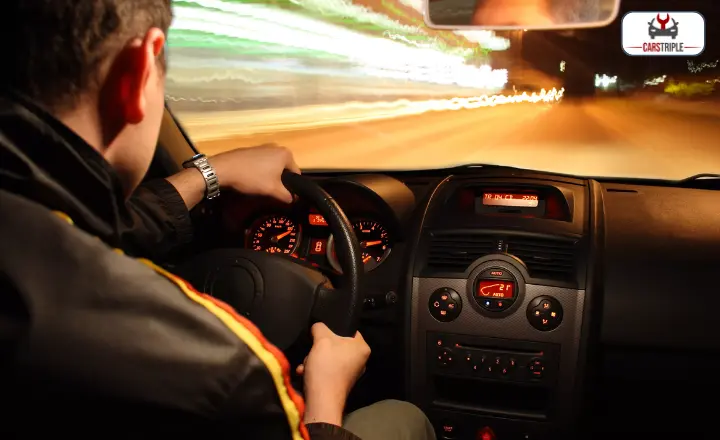Revving engines, screeching tires, and billowing smoke—the iconic imagery of burnout is enough to get any car enthusiast’s heart racing. But when it comes to performing a burnout in an automatic transmission vehicle, many people assume it’s impossible or not as thrilling as in a manual. In this guide, we’ll explore how to burnout in automatic.
If you’re a seasoned gearhead looking for new challenges or simply curious about pushing your car’s limits within legal boundaries, mastering the technique of doing a burnout in an automatic will undoubtedly take your driving experience to new heights.
Automatic transmissions may not offer the same level of control as their manual counterparts when it comes to burnout, but that doesn’t mean they’re incapable of delivering an exhilarating display of power and skill.
How to burnout in automatic?
Driving a car with an automatic transmission may seem like a breeze, but burning out in an automatic is still possible. One way to accomplish this is by engaging the gas pedal and pressing down hard while keeping the brake engaged. This creates significant stress on the transmission and can cause it to overheat, leading to potential damage or failure.
Burning out in an automatic is by revving the engine while shifting between drive and reverse repeatedly. This sudden change in gear engagement can put undue strain on the transmission and lead to internal components wearing out faster than usual.
Constantly switching between drive and reverse without allowing time for the transmission to engage fully can cause excessive heat buildup, further increasing the risk of burnout.
Automatic transmissions are designed for ease of use, they are not immune to burnout when used improperly. By understanding these potential pitfalls and treating your automatic transmission with care, you can help avoid costly repairs due to burnout.

Why Do Burnouts?
Most car models are not intended for performing burnouts, but automated vehicles can still achieve this due to their lack of a clutch, making it a simpler task. Certain cars, such as the latest Ford Mustang, have a special driving mode to facilitate this.
It is important to ensure that the vehicle’s internal components are in good condition before attempting a burnout. Despite this, engaging in burnouts can enhance one’s enjoyment of the automotive world. The sight of spinning tires, billowing smoke, and loud noise can be exhilarating and entertaining for enthusiasts.
There are various types and sizes of burnouts, from the aggressive displays of power by vehicles like the Ford Mustang and Dodge Charger to those of upscale models like the E63 AMG Mercedes.
On the opposite end of the spectrum, some drivers engage in squealing, unpleasant, rubber-burning sessions reminiscent of the Honda Civic style. These drivers can be easily spotted by their front-wheel-drive (FWD) hatchbacks that seem to float on clouds rather than their front tires, emitting a loud, scratchy, popping noise due to the excessive rapid motion of the front tires.
This generates heat and friction, allowing the driver to burn rubber while navigating intersections. The same phenomenon occurs when Subaru Impreza WRXs perform all-wheel drive (AWD) jumps from meeting to stoplight.
On a completely different note, observing a motorcycle doing a burnout at a stoplight is a unique experience. As all the weight rests on the front tire, they accelerate to the rev limiter while generating noise as their tires reach maximum speed.

Biologists have been studying this behavior for at least a century but are still working to understand its motivations. Is it an act of defiance against authority? Are they trying to warm up fresh tires in preparation for an upcoming drag race to improve grip? Or do they engage in these activities simply because they want to?
Is Doing Burnouts Illegal?
If you insist on burning out, you’re playing a dangerous game. Causing damage to property without the landowner’s permission could result in a fine of up to $1,000. Parking lots typically have painted lines that can be worn out by reckless behavior like spinning tires.
The property owner would then have to pay to have the lines repainted, costing them money. Many private buildings around parking lots have high-quality cameras that can capture your actions, so be aware that your license plate can be easily identified.
If you’re thinking about doing a burnout on a public road, there are some additional factors to take into account. Firstly, make sure there are no people nearby obstructing the road or in the path of oncoming traffic. You don’t want to end up being the center of attention like a Ford Mustang driver leaving every car and coffee event.
It’s important to remember that all of these considerations should be made before attempting any burnout or drift, and I’m assuming you’re willing to disregard any local laws that prohibit it. From my experience, driving an enthusiastic car often leads to engaging in illegal activities.
How To Do A Burnout In An Automatic (Front Wheel Drive)
- Find a wide, open space free of any obstacles or pedestrians to ensure safety.
- Turn off the traction control by locating the button or switch in your vehicle.
- Press firmly on the brake pedal with your left foot and rev the engine up to around 3,000–4,000 RPMs with your right foot.
- While still holding down the brake pedal, release pressure from the accelerator for a brief moment, allowing the wheels to spin.
To achieve a successful burnout in an automatic front-wheel-drive car, it’s important to understand that power braking is key. By firmly pressing on the brake pedal and revving up the engine simultaneously, you can generate enough torque to make the tires break loose and start spinning.

Performing burnout should only be done in safe and legal environments where there are no risks involved. Mastering this technique takes practice and patience but can certainly provide an exhilarating experience when executed properly.
How To Do A Burnout In An Automatic (Rear Wheel Drive)
- Ensure your vehicle is in a safe, open area with no traffic or pedestrians nearby to avoid any accidents.
- Press the brake pedal firmly with your left foot while keeping your right foot on the gas pedal.
- Rev the engine to a high RPM, around 3000-4000, by gently applying pressure on the gas pedal.
- While maintaining pressure on both pedals, release the brake pedal gradually and allow the tires to spin freely.
- Keep a firm grip on the steering wheel to maintain control of the vehicle during the burnout.
- Once you’ve finished performing the burnout, release pressure from both pedals and allow the car to come to a complete stop before resuming normal driving.
Performing a burnout in an automatic rear-wheel-drive vehicle can be an exhilarating experience when done safely and responsibly. By following these steps and taking necessary precautions, you can enjoy showcasing this impressive maneuver. Remember to always prioritize safety and be mindful of your surroundings when attempting any driving techniques.
Tips For Doing A Burnout With An Automatic Transmission
Performing a burnout with an automatic transmission requires finesse and technique. To start, ensure your car is in a safe and legal location with ample space.
Next, deactivate traction control or stability programs to unleash the full power of your vehicle. When you’re ready to begin, firmly press the brake pedal with your left foot while accelerating gently with your right foot.
Once the tires start spinning, gradually release the brake while maintaining throttle pressure to sustain the burnout. It’s essential to be mindful of your surroundings and avoid overheating your transmission or damaging other components. Keep an eye on engine temperatures, and be prepared to stop if things get excessively hot.
Consider using water or tire treatment products for enhanced smoke and visual effects during burnout. Remember that practice makes perfect, so start slowly and gradually build up to more prolonged burnouts as you become more comfortable with the technique.
Performing a burnout should always be done responsibly and within legal boundaries. Always prioritize safety for yourself and others around you when attempting any automotive stunts or maneuvers.
Conclusion
Learning how to burnout in automatic vehicles requires practice, patience, and a thorough understanding of the mechanics involved. By following the steps outlined in this guide, you can master the art of burning out in an automatic car and impress your friends at the track or on the street. It is important to always prioritize safety and adhere to local laws and regulations when attempting such maneuvers.
Remember that burning out can put a lot of stress on your vehicle’s components, so it’s essential to be mindful of potential wear and tear. Whether you’re a seasoned enthusiast or just starting, take the time to perfect your technique and enjoy the thrill of executing a successful burnout responsibly. Stay safe and have fun!
FAQS
What is a burnout in an automatic car?
A burnout in an automatic car occurs when the driver spins the tires while holding the vehicle stationary.
Are there legal implications for performing a burnout in an automatic car?
Yes, performing a burnout on public roads can result in fines or legal consequences, depending on local laws.
